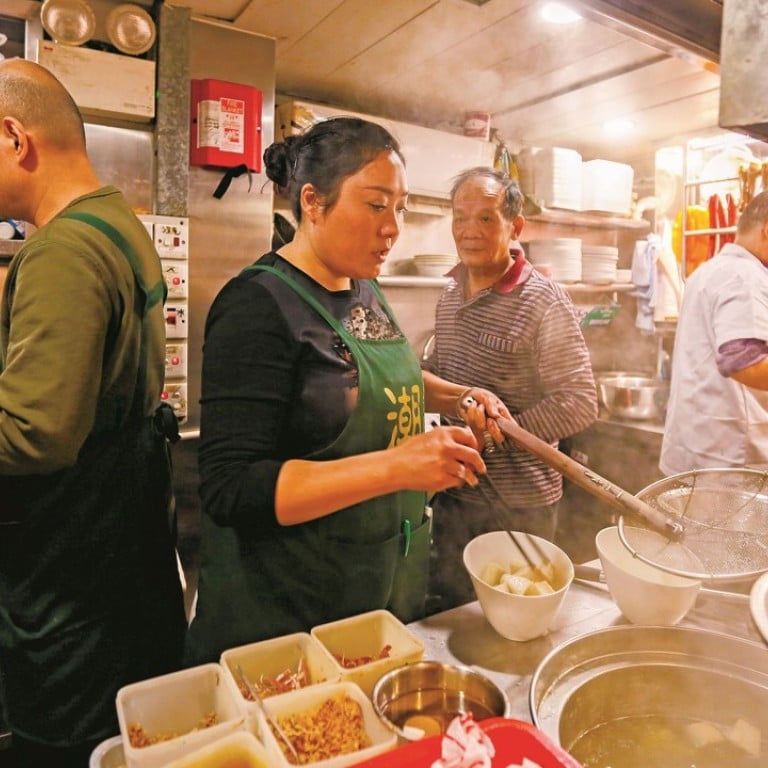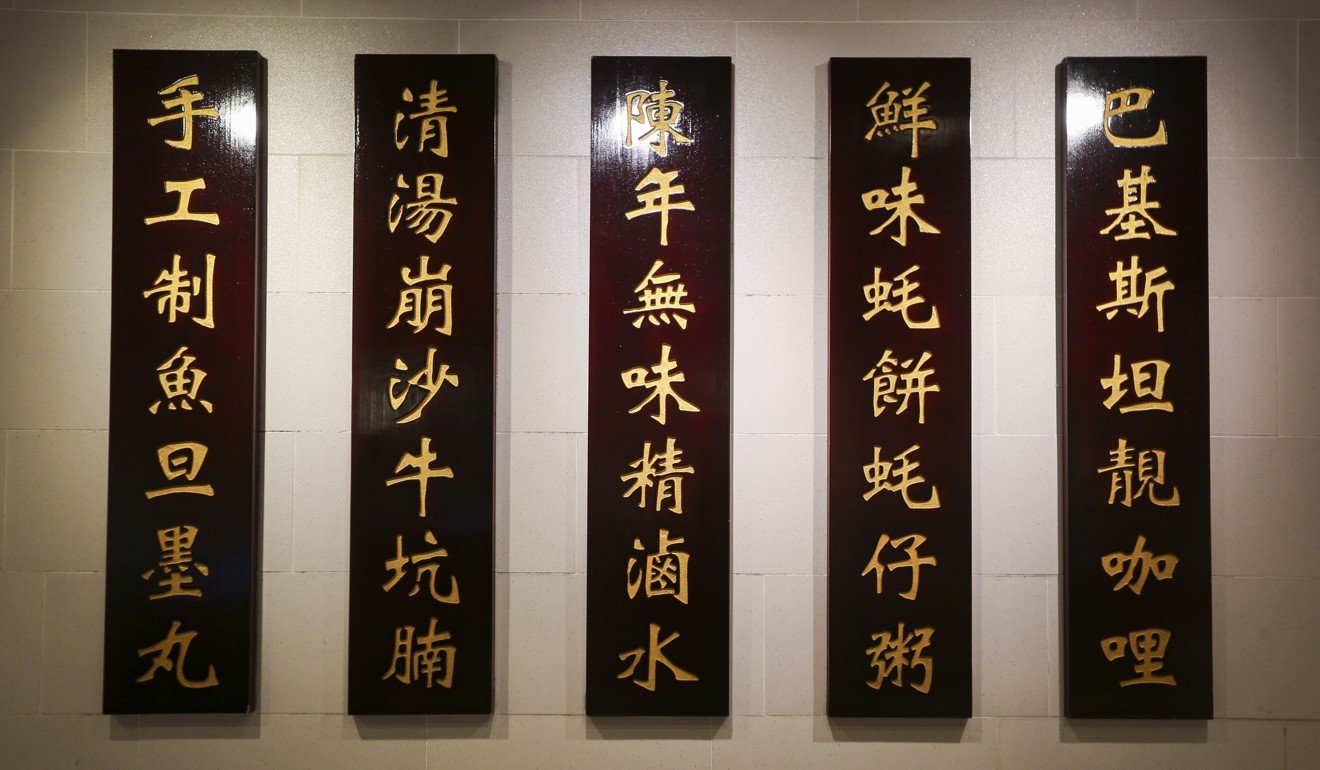
Chinese regional cuisine: the secrets of Chiu Chow dishes from the south, and where to eat them in Hong Kong
Soy goose, braised goose, chilled crab, oyster congee – owners of three restaurants, one of them newly listed by Michelin, explain what goes into making the hearty dishes migrants brought with them from Guangdong
“I remember that day – someday in May – two persons walked in and ordered our signature dishes. They looked just like usual customers and we entertained them just like we normally did,” recalls Eddy Lee, the owner of Chiu Chow Delicacies.
They turned out to be Michelin inspectors who rate restaurants and compile the annual Michelin Guide to Hong Kong and Macau.
Top five roast goose restaurants in Hong Kong
“They handed their business cards to my colleague when paying the bill. They requested to talk further with me. I was shocked and excited,” Lee says with a grin.
Chiu Chow Delicacies, a small restaurant at North Point, is a newcomer to the Michelin Guide Hong Kong & Macau for 2018. News of its place in the Bib Gourmand section of the guide – for restaurants offering good food at reasonable prices – quickly generated buzz and business increased, leading to long queues outside the shop.
Impatient foodies not willing to wait for seats would order a box of daa laang to take away. Daa laang refers to cooked and marinated meats.
This style of cooking – primarily using goose meat, but also pork, eggs and tofu – originated in Chaozhou (Chiu Chow, as it’s called in Cantonese), in the eastern part of Guangdong province, southern China, and reached Hong Kong via migrants who arrived in the 1950s. It is one of the cuisine’s most recognisable features.

Soy goose is one of the dishes that wooed the Michelin judges that day, says Lee. He says the secret to the dish’s flavour lies in the marinade. A vat of marinade bubbles around the clock and gets replenished every three days. “It gets more aromatic and palatable day by day, just like wine getting mellow and richer as it ages,” says Lee.
While the restaurant’s recipe is a well-kept secret, Lee says, “ours is lighter than those offered in other restaurants. The sauce can’t upstage the goose; it is subtle but not too mild.”
Only my father knows [our secret recipes] but I won’t ask for them until I officially take my father’s place
In the old days when food was scarce and life was tough, hard-working Chaozhou migrants in Hong Kong preserved foods by treating them with a lot of salt. That is why Chiu Chow cuisines were traditionally salty. However, excessive sodium intake is frowned upon today and food businesses have to adapt.
The liver of the bird – marinated like the goose meat – is a luxury. But unlike very fatty foie gras, the liver offered here won’t leave you feeling guilty.
“Foie gras dishes available in classy French restaurants are fatty as the liver comes from force-fed goose,” says Lee. “Ours are from healthy Shitou goose [a speciality from Shantou in eastern Guangdong that gets the name for the bird’s resemblance to a lion’s head, and which is treasured for its robust and densely textured meat]. The liver is palm-sized, no less smooth than the expensive type but not that greasy. It’s decadent but free of guilt.”

Hong Kong restaurateur Vivien Shek’s dining tips – Chiu Chow, kaiseki and matcha heaven
Lee says they sell 40 to 50 geese, each weighing 10kg (22lb), and 30 to 40 livers every day.
Pak Loh Chiu Chow restaurant in Causeway Bay still prepares and flavours its dishes the traditional Chiu Chow way. “Had we made adaptations, they couldn’t be called Chiu Chow dishes and we would lose our unique appeal. We don’t do fusion dishes,” says Rainbow Ma, executive general manager.

Chilled crab, a dish at the top of the must-try list, epitomises the seafood dishes in which Chiu Chow cuisine excels. The crabs used in the restaurant are harvested in Shantou. Each 1kg (2lb) specimen undergoes an unusual process of blood-letting to maximise freshness.
“We place it on the chopping board and spike its abdomen with a knife, then the blue blood will come out,” says executive chef Lam Chun-yung. “If the blood is not released thoroughly and in a timely manner, the residue will spoil the flesh’s taste, leaving an unpleasantly earthy note.”

The crabs are steamed without any seasoning for 30 minutes before being left to cool at room temperature. While they take three hours to cool down, Lam insists they can’t quicken the process by refrigerating them.
“Nothing is better than natural air to chill food and keep its flavour intact,” he says. The dish is served with a dipping sauce of vinegar and minced ginger which balances the crabs’ cooling property (when considered from the perspective of traditional Chinese medicine). The tender crabmeat bursts with umami flavours, showing that any additional seasoning is unnecessary.
Michelin confirms Hong Kong & Macau guide is sponsored, but by companies not the cities’ tourism boards
The dish that has best stood the test of time is braised sliced goose. For the past 50 years, the kitchen has used Shitou goose and its special house-made marinade, a time-tested recipe created by the earliest generation of chefs.
The ingredients, which are stuffed into a sachet, include star anise, cinnamon, peppers, herbs and spices. Lam explains that, while other restaurants use almost the same ingredients,the proportion in which each is used is what makes Pak Loh Chiu Chow’s marinade different.
It takes two spice sachets to prepare a pot of broth for marinating the goose.
“Every day we take out one of the sachets and replace it with a new one. As soon as the broth is boiling, we put the goose in for around an hour until it is thoroughly cooked. Then we take it out, hang it up, and poke holes all over its body with a bamboo stick before dousing it in the broth again for another 20 minutes.”

Another common ingredient in Chiu Chow cuisine is oysters, which are farmed in the Chaozhou region. The oysters come in various sizes.
At Pak Loh, big oysters go into congee, while small ones are prized for their creamy sweetness and are reserved for baby oyster omelettes. For these a batter is made with sweet potato flour – which gives the dish a stretchy texture – to which a chicken egg and a duck egg are added. It’s seasoned lightly with pepper power and fish sauce, before the oysters are mixed in, then fried in oil.
Had we made adaptations, they couldn’t be called Chiu Chow dishes and we would lose our unique appeal
Lee, of Chiu Chow Delicacies, says medium-sized oysters are best for oyster congee. Chiu Chow congee is very different from the Cantonese version, in which rice and water are cooked to a thick, gooey consistency; it is cooked rice in soup – the rice grains remain whole and settle at the bottom of the bowl. Lee describes the milky broth as “the soul of the bowl”, and says it’s made of pork bone and chicken, flavoured with ginger, garlic, pepper and assorted spices.
Not all Chiu Chow restaurants charge customers a high price for seafood, and Sang Cheung Seafood Restaurant in Tai Wai offers a bargain. A variety of seafood is displayed in tanks with price tags clearly marked so that customers can pick and choose their favourites and how they want them cooked.
A local crab ranges in price from HK$100 to HK$380 (US$13 to US$49). “We don’t import crabs from Chaozhou for fear that its flavour and texture will be affected during transport,” says manager Scarlett Lau.
For less than HK$100, you can have a hearty bowl of scorched blood cockles; if you want a richer and stronger flavour, the ridged bivalves can be cooked with Chinese wine instead.
Hong Kong and Macau Michelin Guide: Peninsula gets first star, three-star restaurants keep theirs
“We cater to average people with our grass-roots-friendly prices,” says Lau. She often spends days in Chaozhou sampling local delicacies with her father, who opened the restaurant 18 years ago.
“Tasting tours at local restaurants gave us inspiration. My father has many local friends who introduced him to sound ingredients and experienced local chefs. It gives us the privilege to access quality seafood that only the local gourmet chefs know.”
More than half of its chefs are Chaozhou natives, she says. “There is a sort of kitchen culture among Chiu Chow food businesses that indigenous chefs should be hired and at the helm.” Brought up in a family where her grandfather used to make Chiu Chow daa laang and her father made and sold Chaozhou-style fish balls at local markets, Lau became a food lover and developed an interest in Chiu Chow cuisine.
“Sometimes I would follow my father to make daily purchase at wet markets, to learn the ropes of picking good seafood. He is a master in that.”

“Only my father knows,” Lau grins, “but I won’t ask for them until I officially take my father’s place. There’s an unwritten practice in the Chinese restaurant kitchen that nobody should ask for secret recipes and techniques. I’ll observe it, although I am his daughter,” she says, laughing.
In contrast to Lau’s optimism, Lee of Chiu Chow Delicacies sees a bleak future for Chiu Chow cuisine.
Susan Jung’s recipe for Chiu Chow-style marinated cockles
“I can’t say for sure if I’ll carry on the business down the line and there could be only a handful of Chiu Chow restaurants left in Hong Kong. The younger generation is reluctant to do Chiu Chow food, as it is a [labour-intensive] trade that involves working over a steaming hot wok to prepare broth, rinsing and processing poultry and getting your hands dirty,” Lee says.
Chiu Chow Delicacies, Shop 4, G/F, Ngan Fan Building, 84-94 Wharf Road, North Point, tel: 3568 5643; takeaway store: Shop 4, G/F, 83 Electric Road, Tin Hau, tel: 3705 2542
Pak Loh Chiu Chow Restaurant, 23-25 Hysan Avenue, Causeway Bay, tel: 2576 8886
Sang Cheung Seafood Restaurant, 151, Ha Keng Hou Village, Tai Wai, tel: 2687 2998
